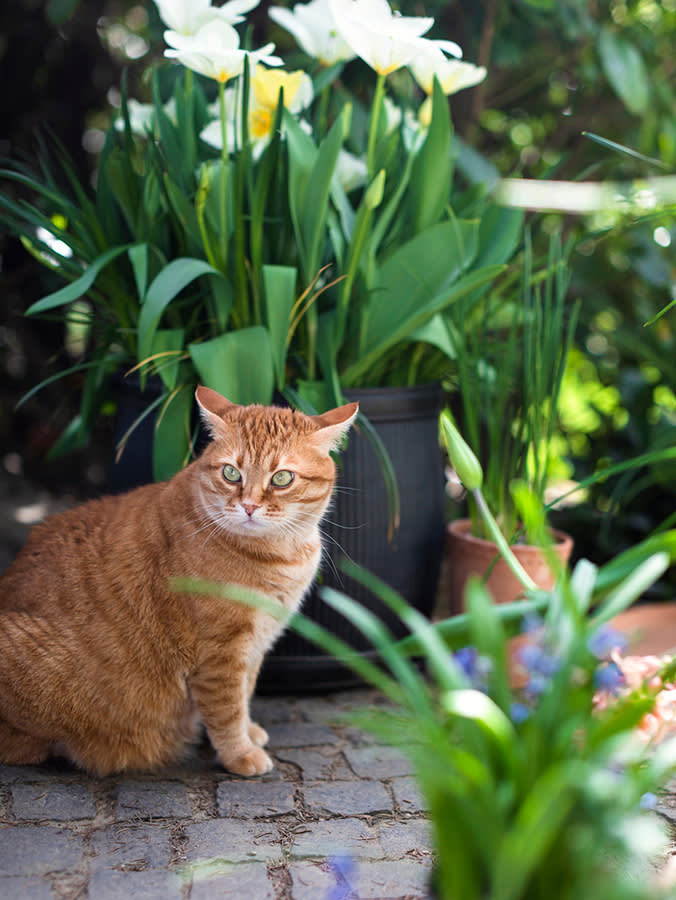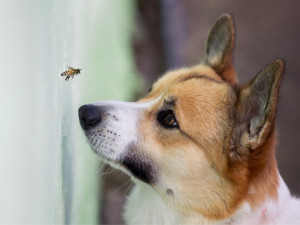What to Do If Your Cat Gets Stung By a Bee
It’s not always as simple as removing the stinger. Find out everything you need to know.
Curious cats are no strangers to trouble. They’ll climb unstable towers and hunt endlessly, chasing toys, housemates, and toes. Some of these proud little hunters will focus their efforts on bugs, including bees and wasps.
A successful catch typically results in a swollen paw or face, but some cats are allergic to bee stings and can suffer more serious consequences. You should know when some simple first aid will do and when you need to haul tail to the vet.
Save on the litter with color-changing tech that helps you better care for your cat.
What are the common symptoms of a cat being stung by a bee?
The most common symptoms of bee stings in cats are local swelling and pain. Cats tend to use their paws and faces to hunt and explore, so that’s where they’re most likely to get stung. The initial reaction is typically along the lines of “crap, that hurt,” making cats jump or vocalize. The pain will trigger limping, licking, or pawing at the site of the sting. Many cats will develop swelling, causing their paws to look like tiny boxing gloves or their faces to look like they just took a punch. Cats with mild symptoms tend to recover from bee stings within 12 to 24 hours.
Most cats won’t experience anything more than pain and swelling after getting stung, but cats who have an allergy or hypersensitivity to bee stings will develop more severe symptoms. These cats are at risk for developing an anaphylactic reaction, which can result in life-threatening symptoms. Symptoms of an anaphylactic reaction to bee or wasp stings include:
What should I do if my cat is stung by a bee?
If your cat is showing any signs of an anaphylactic reaction, they should be taken to a veterinarian right away. Cats who sustained multiple stings or have been stung in a dangerous location, like say, the tongue or the eye (ouch) should also receive prompt medical care. It’s best to seek treatment before things get worse.
If your cat was stung by a bee and seems OK, you can:
1. Remove the stinger.
Finding a stinger in a cat’s fur is no easy task. It’s easier to find Waldo in a Texas-sized Christmas poster full of candy canes and Santa hats. But it’s worth taking a look; taking out the stinger can help speed recovery. If you happen to hit the jackpot and find the stinger, use your fingernail or a stiff card (like a credit card or driver’s license) to scrape it out. Try to avoid squeezing the stinger with fingers or tweezers, as this runs the risk of breaking the stinger or releasing more venom into the skin.
2. Apply a cool compress.
This can help to reduce swelling and pain. A bag of frozen veggies or a cold, wet washcloth can do the trick.
3. Monitor your cat’s behavior.
Even if your cat seems OK immediately after getting stung by a bee, keep a close eye on them to ensure their symptoms don’t get more severe. Signs of a more severe reaction can be delayed by an hour or more. When in doubt, contact a vet.
How can I relieve my cat’s discomfort from a bee sting?
Removing the stinger and applying a cool compress is the best way to ease the pain after a cat gets stung by a bee. Do not give any over the counter medications for pain. Drugs like acetaminophen (Tylenol) and ibuprofen (Advil, Motrin) are super toxic to cats. If your cat’s discomfort isn’t getting any better, contact a veterinarian.
How to diagnose a bee sting allergy in cats
Cats who are truly allergic to bee stings will experience more than just mild pain and swelling. They can develop gastrointestinal upset, breathing changes, and weakness or disorientation. These cats should get veterinary care ASAP. Your veterinarian will perform a physical exam and further testing to determine the severity of the reaction. This may include blood pressure monitoring, blood work, and imaging.
What are the causes of bee sting allergy in cats?
Bee and wasp venom contains proteins and other substances that can trigger a strong immune response in cats. This exaggerated response involves the lungs, skin, gut, and cardiovascular system — leading to trouble breathing, redness, hives, vomiting and diarrhea, and poor circulation.
What is the treatment of bee sting allergy in cats?
Cats who develop mild symptoms after a bee or wasp sting typically receive outpatient care. This may include pain medication or an antihistamine. Cats who are experiencing an anaphylactic reaction often require aggressive treatment. This may include:
IV fluids
Cats in anaphylactic shock are exactly that — in shock. IV fluids help address poor circulation and low blood pressure. They can also help with hydration if a cat develops vomiting and diarrhea.
Oxygen
Cats in shock will often have difficulty breathing, and supplemental oxygen can help stabilize them.
Medications
Your veterinarian will administer medications based on your cat’s symptoms. This can include an antihistamine such as Benadryl, or in more severe cases, epinephrine, bronchodilators, and corticosteroids.
Addressing the area
Tell the veterinary staff if the stinger may still be in your cat and the area of the body that it may be found. It’s not guaranteed that the stinger will be found, but another set of eyes won’t hurt. This is not as important as medications and other life-saving measures.
Monitoring
It’s quite common for cats to be hospitalized for a day or so after experiencing an anaphylactic reaction. Continued monitoring is needed to determine if medications need to be repeated and if your cat is recovering as hoped.
Can I use home remedies like baking soda or vinegar for a bee sting on my cat?
Home remedies, like baking soda paste or vinegar, are unlikely to be effective in treating bee or wasp stings in cats. They can even cause harm if a cat ingests too much of either substance or if it gets in their eyes.
Can I prevent my cat from being stung by bees?
The best way to prevent a cat from being stung by a bee is to keep them away from areas with bees. Keep your cat indoors — especially during peak bee hours, which are usually early morning and late afternoon. If a cat does venture outside, avoid giving them access to areas where bees are known to nest, such as flowers, bushes, and trees.
Little can be done to squash a cat’s desire to chase and pounce bugs, and catching a bee will lead to discomfort at the very least. In cases of more severe symptoms, prompt veterinary care can provide life-saving care and help speed recovery.













